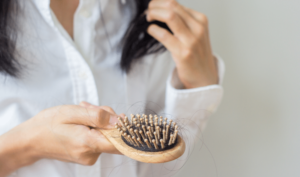 The normal cycle of hair growth lasts for 2 to 6 years and each hair grows approximately one centimeter (less than half an inch) per month during this phase. About 90 percent of the hair on your scalp is growing at any one time. About 10 percent of the hair on your scalp, at any one time, is in a resting phase. After 2 to 3 months, the resting hair falls out and new hair starts to grow in its place.
The normal cycle of hair growth lasts for 2 to 6 years and each hair grows approximately one centimeter (less than half an inch) per month during this phase. About 90 percent of the hair on your scalp is growing at any one time. About 10 percent of the hair on your scalp, at any one time, is in a resting phase. After 2 to 3 months, the resting hair falls out and new hair starts to grow in its place.
It is normal to shed some hair each day as part of this cycle. However, some people may experience excessive (more than normal) hair loss. Hair loss of this type can affect men, women and children. Genetic baldness is caused by the body’s failure to produce new hairs and not by excessive hair loss.
Both men and women tend to lose hair thickness and amount as they age. Inherited or “pattern baldness” affects many more men than women. About 25% of men begin to bald by the time they are 30 years old, and about two-thirds are either bald or have a balding pattern by age 60.
Male-pattern baldness is the most common cause of hair loss in men. Men who have this type of hair loss usually have inherited the trait. Men who start losing their hair at an early age tend to develop more extensive baldness. In male-pattern baldness, hair loss typically results in a receding hair line and baldness on the top of the head.
Women may develop female-pattern baldness. In this form of hair loss, the hair can become thin over the entire scalp.
Causes
The following describes some of the many things that cause hair loss:
- Hereditary thinning or baldness (also called androgenetic alopecia): This is the most common cause of hair loss. It affects men and women. About 80 million people in the United States have hereditary thinning or baldness. When men have hereditary hair loss, they often get a receding hairline. Many men see bald patches, especially on the top of the head. Women, on the other hand, tend to keep their hairline. They see noticeably thinning hair. The first sign of hair loss for many women is a widening part. In rare cases, men see noticeably thinning hair. And in rare cases, women can see a receding hairline or bald patches. The reasons for this are unknown.
- Alopecia areata: Researchers believe that this is an autoimmune disease. Autoimmune means the body attacks itself. In this case, the body attacks its own hair. This causes smooth, round patches of hair loss on the scalp and other areas of the body. People with alopecia areata are often in excellent health. Most people see their hair re-grow. Dermatologists treat people with this disorder to help the hair re-grow more quickly.
- Cicatricial (scarring) alopecia: This rare disease develops in otherwise healthy people. The disease destroys a person’s hair follicles. Scar tissue forms where the follicles once were, so the hair cannot re-grow. Treatment tries to stop the inflammation, which destroys the hair follicles.
- Central centrifugal cicatricial (scarring) alopecia: This type of hair loss occurs most often in women of African descent. It begins in the center of the scalp. As it progresses, the hair loss radiates out from the center of the scalp. The affected scalp becomes smooth and shiny. The hair loss can be very slow or rapid. When hair loss occurs quickly, the person may have tingling, burning, pain, or itching on the scalp. Treatment may help the hair re-grow if scarring has not occurred.
- Underlying medical condition: Hair loss can be the first sign of a disease. About 30 diseases, including thyroid disease and anemia, cause hair loss. By treating the disease, hair loss often can be stopped or reversed.
- Illness: Significant hair loss can occur after an illness. A major surgery, high fever, severe infection, or even the flu can cause hair loss. Your dermatologist may call this type of hair loss telogen (tee-lə-jen) effluvium (ih-flu-vee-uhm).
- Some cancer treatments: Radiation therapy and chemotherapy can cause hair loss. This hair loss is often temporary, but it can cause great distress.
- Ringworm of the scalp: This disease is contagious and common in children. Without effective treatment, ringworm can cause balding.
- Trichotillomania: This medical disorder causes people to repeatedly pull out their own hair. They often feel a constant urge to pull out the hair on the scalp. Some sufferers say they feel compelled to pull out their eyelashes, nose hairs, eyebrows, and other hairs on their bodies.
- Giving birth: After giving birth, some women have noticeable hair loss. Falling estrogen levels cause this type of hair loss. The hair loss is temporary. In a few months, women see their hair re-grow.
- Menopause: Hair loss is common during menopause. This loss is often temporary. Hair re-grows with time. If a woman is 40 years of age or older, she should not expect her hair to have the fullness that it did when she was younger.
- Stress: Experiencing a traumatic event (e.g., death of a loved one or divorce) can cause hair loss.
- Weight loss: Some people see hair loss after losing more than 15 pounds. The hair loss often appears 3 to 6 months after losing the weight. This hair loss is common. The hair re-grows without help.
- Vitamin A: Too much vitamin A can cause hair loss. People can get too much of this vitamin through vitamin supplements or medicines. Once the body stops getting too much vitamin A, normal hair growth resumes.
- Protein: When the body does not get enough protein, it rations the protein it does get. One way the body can ration protein is to shut down hair growth. About 2 to 3 months after a person does not eat enough protein, you can see the hair loss. Eating more protein will stop the hair loss. Meats, eggs, and fish are good sources of protein. Vegetarians can get more protein by adding nuts, seeds, and beans to their diet.
- Iron: Not getting enough iron can lead to hair loss. Good vegetarian sources of iron are iron-fortified cereals, soybeans, pumpkin seeds, white beans, lentils, and spinach. Clams, oysters, and organ meats top the list of good animal sources of iron.
- Eating disorder: When a person has an eating disorder, hair loss is common. Anorexia (not eating enough) and bulimia (vomiting after eating) can cause hair loss.
Some prescription medicines can cause hair loss. These include:
- Blood thinners.
- High-dose vitamin A.
- Medicines that treat arthritis, depression, gout, heart problems, and high blood pressure.
- Birth control pills: Some women who take the pill see hair loss. Sometimes, the hair loss begins when a women stops taking the pill. Women who get this hair loss often have hereditary hair loss.
- Anabolic steroids (steroids taken to build muscle and improve athletic performance) may cause hair loss.
Your hairstyle and even some of the products you use on your hair can cause hair loss.
- Products: Frequent bleaching or permanents can cause the hair to break. Regular or improper use of dyes, gels, relaxers, and hair sprays also can cause hair breakage.
- Blow dryers, flat irons, and other devices: Frequent use of a blow dryer tends to damage hair. The high heat from a blow dryer can boil the water in the hair shaft leaving the hair brittle and prone to breakage.
- Hairpins, clips, and rubber bands: When used to hold hair tightly, hairpins, clips, and rubber bands can break hair.
Years of wearing hair in a style that pulls on the hair such as a ponytail, cornrows, or braids can cause a type of hair loss known as traction alopecia.
The following practices often cause the hair to break:
- Too much shampooing, combing, or brushing (100 strokes or more a day).
- Rubbing wet hair dry with a towel.
- Brushing or combing wet hair (especially people who are Asian or Caucasian).
- For many people, hair is more elastic when wet. This means it breaks off more easily than dry hair. When hair breakage occurs, the hair appears shaggy or too thin. For people who are of African descent, their hair is not more elastic when wet.
Ayurveda Management of Hair loss / Hair fall

Romakupagata / keshamulagata vitiated pitta (bhrajaka pitta) along with vitiated vata leads to dis-lodgement or withering of the hair from the hair roots. Further to this, vitiated sleshma / kapha along with rakta will cover and causes obstruction to the hair root, which results in no further hair growth from that place.
Khalitya is primarily a Pitta predominant tridoshajanya vyadhi (all three doshas vitiated disease). But based on the predominance of dosha, is divided into following types.
- Vataja Khalitya : In this type, Keshbhoomi or scalp appears as if it is Agnidagdha and it becomes Shyava and Aruna.
- Pittaja Khalitya : In this type the colour of scalp appears as Peeta, Neela and Harita. The scalp is surrounded by the Siras (veins). Sweat may be found all over scalp.
- Kaphaja Khalitya : In this type, the colour of the scalp is more or less same as the colour of skin but here it is Ghana and Snigdha in appearance and the colour tends towards whitish tinge.
- Sannipataja or Tridoshaja Khalitya : In this type of Khalitya, characteristic of all the three Doshas are observed. The scalp looks like burnt and it bears nail like appearance.
At CHARAKA, we offer a very effective treatment methodology based on the classical texts of Ayurveda. The treatment comprises of administration of rasayanas and kesh vardhak yogs/dravyas internally, application of specially formulated oils/powders/packs externally, Panchakarma for detoxification & Kaya kalpa therapies for rejuvenation, which not only helps in preventing hair fall but also in re- growing recently lost hairs.
Apart from medical management, controlling Stress, eating healthy & balanced diet rich in proteins, vitamins and minerals and a healthy life style are extremely necessary to arrest hair loss.

